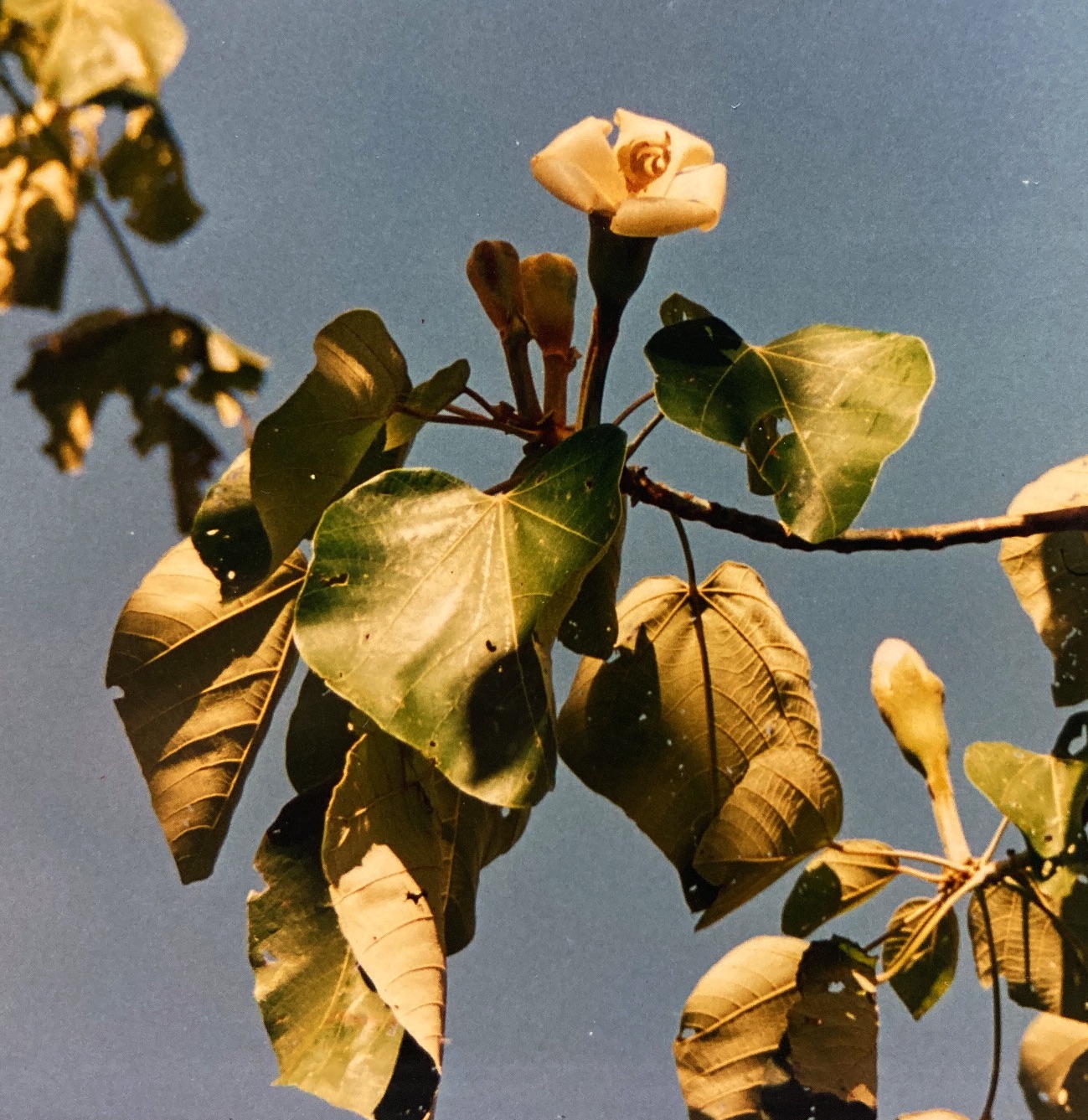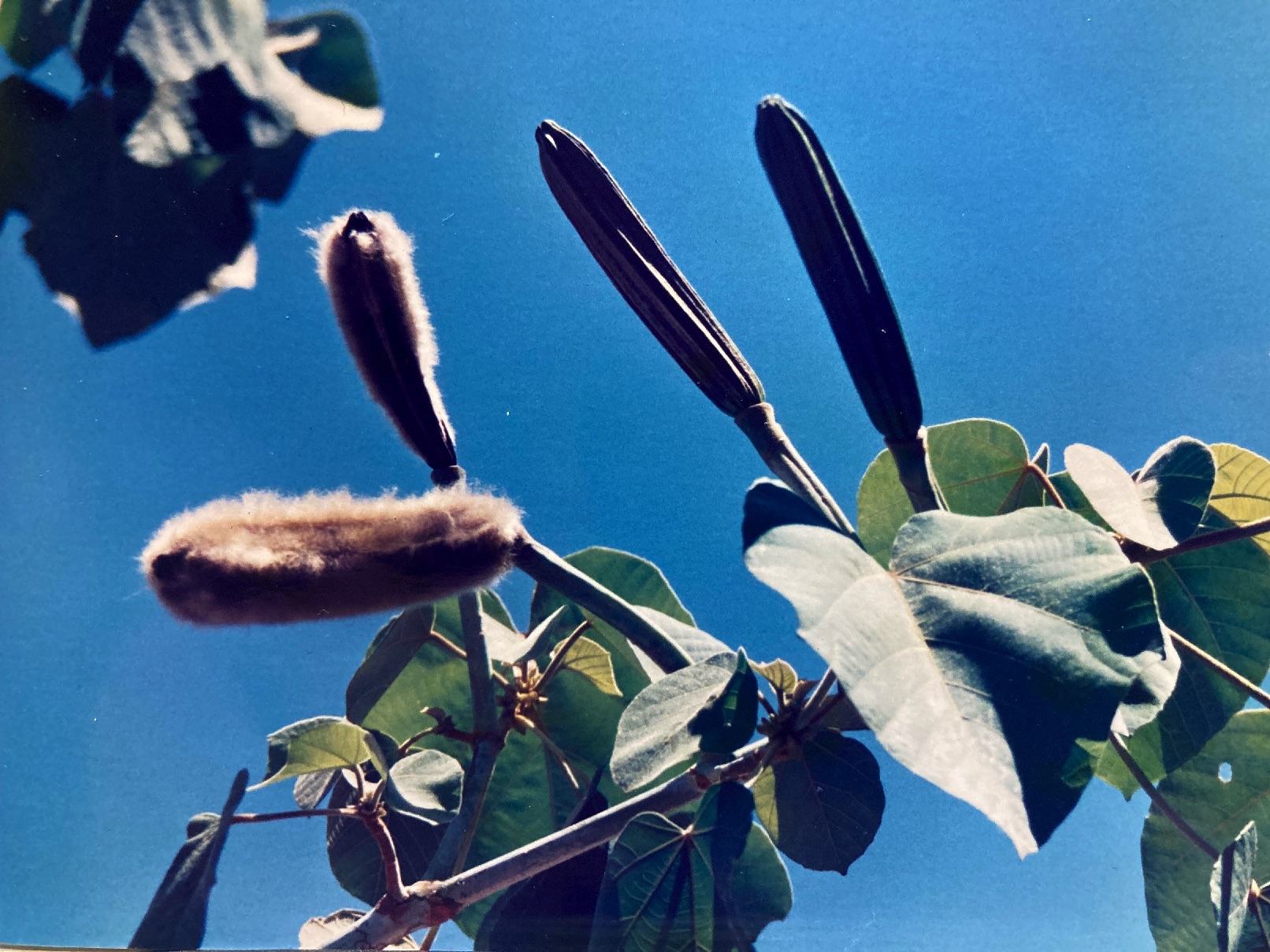Ochroma pyramidale Swartz
Bombacaceae BALSA
Tree: Common, evergreen subcanopy or canopy tree (20-30 m) always found growing in disturbed sites where sunlight is abundant. As such the species frequents secondary forests, light gaps, roadsides, and the flanks of steep cliffs where landslides frequently clear out the vegetation that manages to establish itself there. Balsa also does well in shallow, droughty, and infertile soils where most other species cannot survive. This tree is notable for its unusual ecology as well as for its famous light – but strong – wood.
Description: Balsa boles are very cylindrical and usually quite straight, though it is not uncommon to find gently curving (never angular) trunks. Reaching diameters of up to 1 meter and clad in very smooth, light-gray or whitish bark, even the biggest Balsas lack buttress roots. Branches in this species are thick but they are relatively few in number and the crown they produce is often narrow and always thin. Leaves are very large, simple, and alternately arranged. The shallowly lobed blades measure 30 cm across and are supported by stout petioles, themselves 37 cm long. All parts of the leaves are covered with reddish epidermal hairs, giving them a rough, sandpapery texture. Leaves continue to be generated from the thick branch tips nearly year round – with growth slowing or stopping only during the dry season. Older foliage also continuously dies and is shed, turning from green through yellow and then to brown in the process and often making a considerable noise as they come crashing to the ground.
Balsa flowers are particularly unique and exotic. They begin as large buds whose thick, leathery calyx is formed from five fused sepals that completely cover the developing petals with a protective dome. Soon, this calyx peals back, revealing the white, still folded, hood of petals. Held perfectly upright in the tree, these unopened flowers strongly resemble velvety ice-creme cones – in size (12 cm long by 9 cm in diameter) as well as in shape. When the flower finally opens, the five large, thick, creamy-white petals bend backwards, covering the calyx. Revealed in the center, a large fleshy ball, covered with hundreds of short stamens, is perched at the end of a long, hollow tube anchored deep within the corolla (similar in design to a common Amapola flower). Over a period of several days, as the petals slowly grade from white to yellow and then finally to burgundy, the anthers shed their abundant stores of yellow pollen and die. The ball that holds them finally twists open, exposing a long pistil held safely within. Protected up until now, any pollen deposited on the style is sure to come from a different flower. Balsa trees blossom annually, during the months of December through February, though individuals may only participate during a part of this extended period.
Fruits grow rapidly from the old flower calyxes, appearing as long, ridged green rods (20 cm by 3 cm). When mature, the pods split lengthwise along several seams and allow the tightly packed cotton within them to force its way out. Expanding in the process, this soft material manages to cover the entire structure, coating it in tan-colored fluff. Thus opened, the mature fruit strongly resembles a large rabbit’s foot (hence its old scientific name: Ochroma “lagopus“). Embedded within the cotton are many, small 3-4 mm seeds. Fruiting occurs annually from mid-January through early April.
Similar Species: There are only four tree species present in Manuel Antonio with extremely large, simple leaves: Cecropia (Cecropia peltata), Panama (Sterculia apetala), Vaco (Brosimum utile) and Balsa. The two former species have three-dimensional, creased, and deeply-lobed foliage, while that of Balsa is planar, only shallowly lobed, and lacks creases. Elliptically shaped and devoid of lobes altogether, Vaco leaves share only their large size with those of Balsa.
Natural History: Balsa is a bat pollinated species: its flowers open for the first time only at night. By day, flowers are eaten by Scarlet Macaws and visited by assorted other parrots and Honeycreepers. Parrots also are known to chew on the green pods, extracting the immature seeds for consumption.
Balsa’s small, light seeds are detached from the pods by gusts of wind, clinging to pieces of fluff as they fall. Wind dispersal of this nature necessitates a dry season harvest. Once on the forest floor, seeds will apparently not germinate unless soil temperatures are high enough to indicate that direct sunlight is available. Allen (1956) indicates that fire also aids in stimulating germination. Otherwise, the seeds will remain dormant in cool soil, waiting for a tree-fall, landslide, or even road-cut to provide them with an opportunity to sprout.
Once germinated, Balsa seedlings grow rapidly. Their light but sturdy wood allows them to make significant gains in height while avoiding the time-consuming energy investments required of denser building materials. It is not uncommon to see three year old Balsas, already 7 meters tall and sporting 15 cm girths. Sexual maturing is reached soon thereafter – with some individuals flowering and reproducing in only their second year of life. Relatively short lived trees, all the Balsa’s will be gone before a century has passed – and many of them will die much sooner. Balsa trees are thus highly adapted to secondary forest conditions. True pioneer species, they are able to colonize a damaged site quickly, taking advantage of insolation levels, and droughty, infertile soil conditions that would spell the demise of most primary forest trees.
Uses: The pale Balsa wood has been used in rafts (hence the Spanish common name of balsa) and early airplane construction, due to its light weight and relative strength. Trees planted for this purpose need to be harvested before they get too large, for older trees develop a water-storing capacity in their cores – a condition known as “water-heart” – that ruins the wood. In fact, it is said that when using drills to remove core samples from older trees, spurts of water are often ejected from the bore-hole after the borer is removed (Whitmore, 1983).
Large plantations of this tree were started during the Second World War in what is now Corcovado National Park. They were never used – due to the increased use of aluminum for aviation – and the trees (and their descendants) can still be seen, surrounding the park’s Sirena post.
The cotton produced by Balsa fruits has been used as insulation and pillow stuffing, as has that of many other members of the Bombacaceae family.
Distribution: In Manuel Antonio, Balsas can be seen along the Perezoso trail, clinging to the cliffs of Punta Catedral, and in the hills surrounding Puerto Escondido. In Costa Rica, it is found in all lowland, disturbed sites – on both coasts. It ranges from southern Mexico to Bolivia and is present in the West Indies (Whitmore, 1983).
Photos: Tree Trunk Leaf Leaf2 Flower Flower2 Flower3 Flower4 Flower5 Fruit Fruit2




